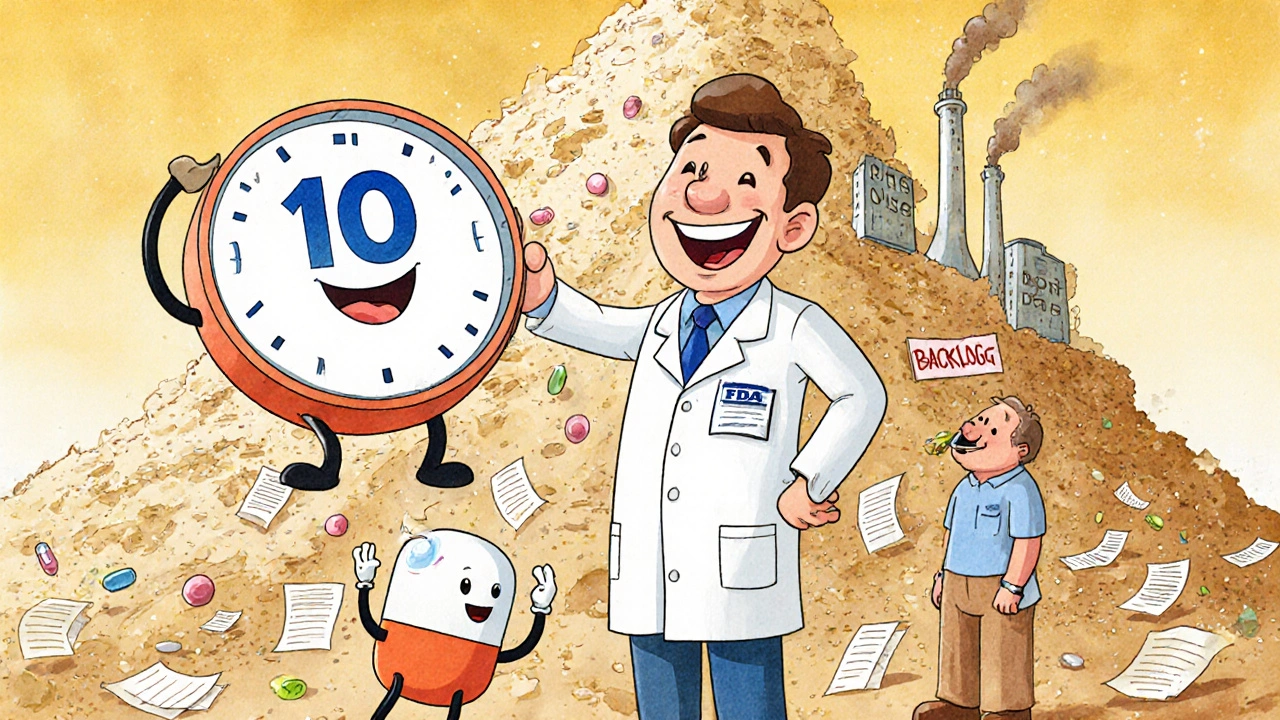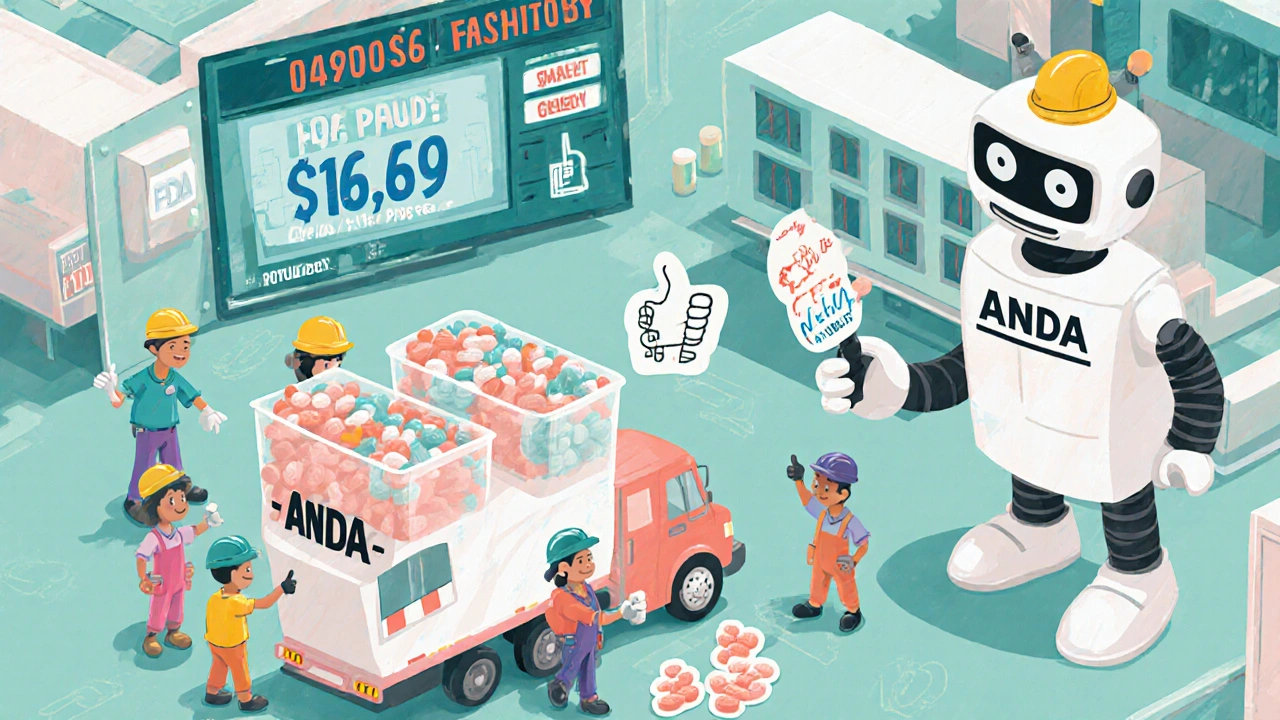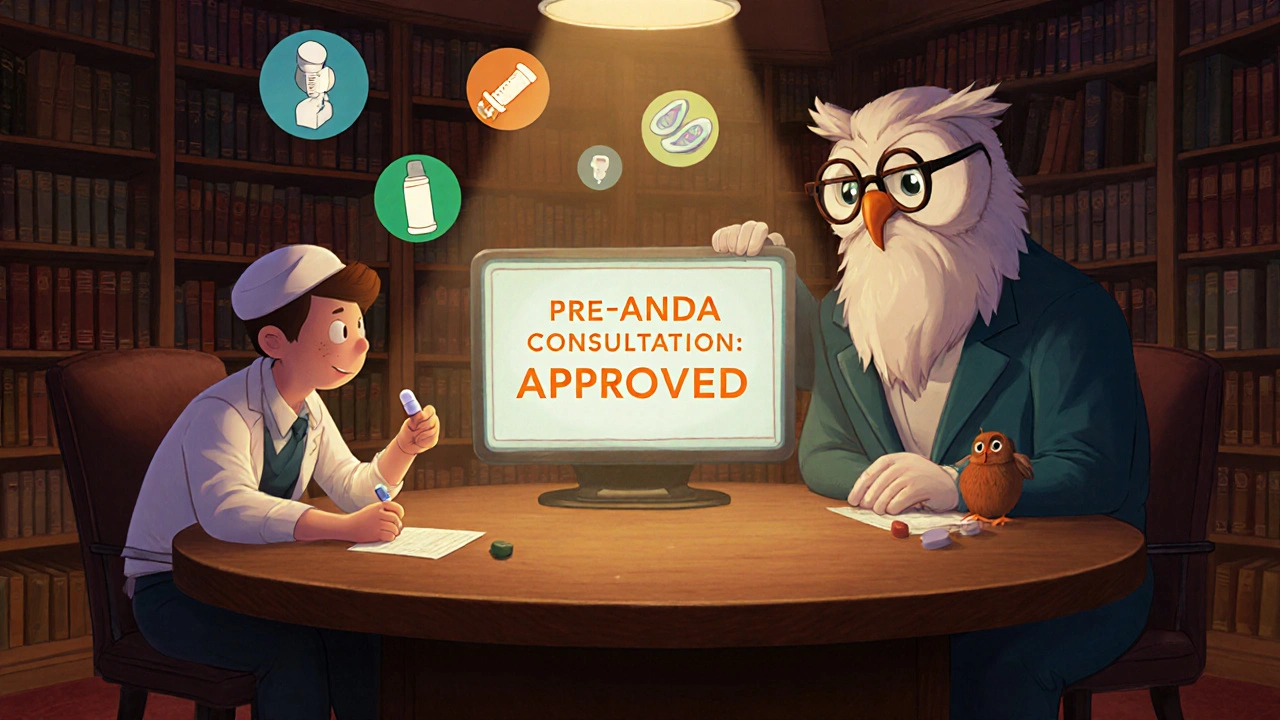Generic Drug User Fee Amendments: How GDUFA Laws Speed Up FDA Review

The U.S. generic drug market supplies about 90% of all prescriptions filled. But behind every cheap pill on the shelf is a complex, tightly regulated process that didn’t always work this way. Before 2012, the FDA was drowning in backlogs - thousands of generic drug applications sat untouched for years. Manufacturers waited, patients waited, and costs kept rising. Then came the Generic Drug User Fee Amendments - or GDUFA - a law that changed everything.
What GDUFA Actually Does
GDUFA isn’t just another regulation. It’s a funding deal. Congress gave the FDA permission to collect fees directly from generic drug makers - not taxes, not government grants, but user fees tied to specific services. In exchange, the FDA promised faster reviews, clearer timelines, and more inspections. It’s a simple trade: industry pays, FDA delivers.
The law was signed in July 2012 as part of the Food and Drug Administration Safety and Innovation Act. Its goal? Cut review times, clear the backlog, and make sure safe, affordable generics reached patients faster. Before GDUFA, it took an average of over three years to approve a generic drug. By 2017, that dropped to under 15 months. Today, under GDUFA III, the FDA aims to review 90% of standard applications within 10 months.
The Fee Structure: Who Pays and How Much
GDUFA fees aren’t one-size-fits-all. They’re broken down by facility type and location. If you make the final pill - that’s a Finished Drug Formulation (FDF) facility - you pay a fee. If you produce the active ingredient (API), you pay another. And if your facility is outside the U.S., you pay more.
Here’s how it breaks down under GDUFA III (effective October 2024):
- Domestic FDF facility fee: $185,589
- Foreign FDF facility fee: $200,589
- Domestic API facility fee: $28,567
- Foreign API facility fee: $43,567
Why the extra $15,000 for foreign sites? It’s not about punishment. It’s about cost. Inspecting a factory in India or China takes more travel, more time, and more resources than inspecting one in Ohio. The fee difference covers that gap.
There are also application fees. Submitting an Abbreviated New Drug Application (ANDA)? That’s a one-time fee. Submitting a supplement to change the formula? Another fee. Even referencing a Drug Master File (DMF) costs money - but only once, when first used.
Total annual fees from industry now exceed $400 million. By law, every dollar must go to generic drug review - not administrative overhead, not research, not marketing. Just reviews, inspections, and related work.
How GDUFA Changed the Game
Before GDUFA, the FDA’s generic program was underfunded and slow. Staff were stretched thin. Inspections were rare. Applications piled up. Some stayed pending for five years.
After GDUFA I launched in 2013, things shifted fast. The FDA hired hundreds of new reviewers. They built a digital tracking system. They started publishing performance data publicly. By 2016, the backlog of pending ANDAs dropped by 70%. The average review time fell from 38 months to 14.
GDUFA II (2018-2022) fixed unintended problems. The original fee structure made it harder for small companies to enter the market. A startup with one product had to pay the same annual facility fee as a giant with 50. So GDUFA II introduced fee reductions for smaller firms and new applicants.
GDUFA III (2023-2027) went further. It added the Pre-ANDA Program - a chance for companies to meet with FDA scientists before even filing an application. This cuts down on rejections later. It also created a formal Controlled Correspondence process, letting applicants ask specific questions and get written answers within 30 days. No more guessing.

Who Benefits - and Who Struggles
Patients win. Generic drugs cost 80-85% less than brand-name versions. GDUFA keeps that pipeline flowing. In 2023, the FDA approved over 1,000 generic drugs - more than ever before.
Large manufacturers win too. They have teams dedicated to compliance, legal teams to handle fees, and global operations to absorb costs. The top 10 generic drug companies now control over half the U.S. market.
But smaller players? It’s tougher. A small U.S. company making just one generic drug still pays over $200,000 a year in fees. For a startup, that’s more than their entire annual budget. Many have stopped applying. Others rely on partnerships with bigger firms just to survive.
Foreign manufacturers - especially from India and China - complain the fee gap isn’t fair. They argue the $15,000 difference doesn’t match actual inspection costs. The FDA says it does. The truth? It’s complicated. Inspections abroad are riskier, longer, and more logistically messy. But the debate continues.
Transparency and Accountability
One of GDUFA III’s biggest changes? Transparency. The FDA now publishes monthly and quarterly reports showing exactly how many applications are reviewed, how many inspections are done, and how long each step takes.
Want to know how long it took to review application #8,472? You can find out. Want to see how many foreign facilities failed inspection last quarter? The data’s online. This level of openness was unheard of before GDUFA.
Manufacturers also get clear performance goals. The FDA doesn’t just say, “We’ll try to be faster.” It says, “We will review 90% of standard ANDAs within 10 months.” If they miss it, they have to explain why - publicly.

What Comes Next? GDUFA IV
GDUFA III expires in September 2027. Negotiations for GDUFA IV are already starting. Stakeholders are pushing for changes:
- Lower fees for small businesses and first-time applicants
- More support for complex generics - like inhalers, injectables, and transdermal patches
- Digital-only submissions to cut paperwork
- Streamlined inspections for facilities with perfect compliance records
The FDA has signaled it’s open to these ideas. But one thing won’t change: the core model. User fees work. They’ve cut review times, cleared backlogs, and kept generics affordable. Without them, the system would collapse.
How Manufacturers Stay Compliant
Getting approved under GDUFA isn’t just about submitting an application. It’s about staying on top of deadlines, fees, and paperwork. Companies need:
- A dedicated regulatory affairs team
- Accurate facility registration data
- Timely fee payments tied to application dates
- Clear understanding of DMF and PAS rules
The FDA offers free webinars, guidance documents, and even a dedicated email ([email protected]) for questions. But most successful applicants hire consultants who’ve been through the process dozens of times.
One common mistake? Missing the fee deadline. If you submit your ANDA but forget to pay the fee, your application is rejected - no exceptions. The system doesn’t wait.
Why This Matters Beyond the U.S.
The U.S. isn’t just a big market - it’s a global standard. If your generic drug can get FDA approval, you can sell it in dozens of other countries. That’s why Indian and Chinese manufacturers fight so hard to navigate GDUFA, even with the higher fees.
But here’s the catch: GDUFA has made the U.S. market harder to enter. Smaller foreign firms are being squeezed out. The result? A more concentrated market. That’s good for efficiency, but bad for competition.
That’s why future versions of GDUFA will need to balance speed, safety, and fairness. The goal isn’t just to approve more drugs. It’s to ensure that the best drugs - from any company, anywhere - can reach patients.
What is GDUFA and why was it created?
GDUFA stands for Generic Drug User Fee Amendments. It’s a U.S. law passed in 2012 that lets the FDA collect fees from generic drug manufacturers to fund the review of generic drug applications. It was created to fix a massive backlog of pending applications and slow review times that were delaying access to affordable medicines. Before GDUFA, it could take over three years to approve a generic drug. Now, the goal is under 10 months.
How much do generic drug companies pay under GDUFA?
Fees vary by facility type and location. As of October 2024, domestic finished drug facilities pay $185,589 annually, while foreign ones pay $200,589. Active pharmaceutical ingredient (API) facilities pay $28,567 domestically and $43,567 overseas. There are also one-time fees for submitting an ANDA, a supplement, or referencing a Drug Master File. Total industry payments exceed $400 million per year.
Does GDUFA favor big companies over small ones?
Yes, initially it did. The original GDUFA I fee structure hit small companies harder because they paid the same annual facility fee as large firms, even if they only made one drug. GDUFA II fixed this by introducing fee reductions for new applicants and smaller firms. GDUFA III continues this trend with targeted support, but critics say more needs to be done to level the playing field.
Are foreign manufacturers treated unfairly under GDUFA?
Foreign manufacturers pay $15,000 more for both finished drug and API facilities. The FDA says this covers the higher cost of inspecting overseas sites. Critics argue the difference doesn’t reflect actual expenses. Many manufacturers from India and China say it’s a barrier to entry, even though they supply most of the U.S. generic drug supply.
What’s the difference between GDUFA I, II, and III?
GDUFA I (2013-2017) created the fee system and cleared the backlog. GDUFA II (2018-2022) added fee relief for small and new companies. GDUFA III (2023-2027) introduced new programs like Pre-ANDA consultations, Controlled Correspondence, and enhanced transparency. Each version builds on the last, with increasing focus on complex drugs and fairness.
What happens after GDUFA III expires in 2027?
Congress must pass new legislation to renew GDUFA. Negotiations for GDUFA IV have already begun. Stakeholders are pushing for lower fees for small businesses, better support for complex generics, and fully digital submissions. If no new law is passed, the FDA will lose its legal authority to collect user fees - which would likely halt the review of new generic drugs.

GDUFA’s a game changer. No more 3-year waits. FDA actually delivers now. Fees fund results. Simple. Effective.
Man i remember when my buddy’s generic blood pressure med got stuck for 4 years. Like wtf. Now? 10 months max. GDUFA’s the reason we’re not all dying waiting for pills. Sure the fees are steep but hey-someone’s gotta pay for the inspectors flying to Hyderabad. At least they’re not just sitting on apps anymore.
This is why I love American innovation. User fees aren’t taxes-they’re investments. The FDA went from broken to best-in-class because they stopped begging for cash and started earning it. More countries should copy this model. Canada’s still stuck in 2005.
Foreign API fees are justified. Inspecting a plant in Punjab takes 3x the resources of one in Ohio. Travel, translators, visas, delays. The $15K isn’t punishment-it’s logistics. Also the Pre-ANDA program? Lifesaver for startups. Stop complaining and use it.
Big pharma loves GDUFA. Small guys? They’re getting crushed. Paying 200k just to file one application? That’s not regulation thats exclusion. And dont even get me started on how the FDA’s transparency reports look great but dont show how many small companies just gave up before even applying
Wow so the FDA finally figured out that if you pay people to do a job they’ll do it? Revolutionary. Also the fact that we’re now debating whether $15,000 is fair for inspecting a factory in India… man we’ve come a long way from ‘just let the pills be cheap’.
you know what i love about this whole thing? its not perfect but its trying. like the pre-anda thing? that’s actual help. not just a wall of forms. and the transparency? finally someone’s showing their work. i dont care if the fees are high if i know why and when my med’s coming. also the fact that they’re talking about digital submissions? yes please. paper is dead
This is such a hopeful story. 💙 People need medicine. The system was broken. Now it’s healing. GDUFA isn’t perfect, but it’s progress. Thank you to everyone working to make generics faster and safer. 🙏
India makes 80% of the world’s generics. We pay double fees. We ship across oceans. We train our engineers to meet US standards. And you still think $15k extra is fair? We’re not criminals. We’re the backbone of your pharmacy shelf. Fix the system not the fee. The FDA needs to stop treating us like suspects.
It’s funny how everyone acts like GDUFA was some miracle. Honestly? It just made the FDA less lazy. Before, they’d sit on apps for years and say ‘we’re understaffed’. Now they have to deliver or get called out publicly. The fees didn’t fix the system-the accountability did. And honestly? That’s what we all need more of. Not more money. More consequences.
My cousin works at a small generic lab in Ohio. They got approved last year under GDUFA III. Took 8 months. Paid $200k in fees. They’re still barely breaking even. But they’re alive. And that’s more than 3 other local labs can say. GDUFA’s not fair but it’s the only game in town. Maybe GDUFA IV can help them survive.
Fee structure is clear. Timelines are published. Transparency is mandatory. Performance is tracked. Compliance is non-negotiable. Deadline? Absolute. No exceptions. This is how regulation should work.
Everyone’s praising GDUFA like it’s the Second Coming. Meanwhile, 90% of the approved generics are made by 5 Indian companies. The rest of us? We’re just paying to keep the oligopoly alive. This isn’t innovation-it’s consolidation with a fancy acronym. And you wonder why drug prices still rise?
So we spent $400 million so the FDA can review pills faster? And you call this progress? What about the $200 billion we spend on brand-name drugs because the generics still take too long? This isn’t fixing the system. It’s just making the machine a little less rusty. Meanwhile, people are still choosing between insulin and rent.